Gearing Up For Halibut 5
The days are ticking away until I head north to begin yet another charter season in Southeast Alaska and low and behold my phone has been ringing to do some last minute seminars here in Washington before I zip outa here. I am adverse to doing seminars these days because of my crazy-busy schedule, but when guys like Ron Garner, Jay Field, and John Keizer call I simply can't say no. Those guys are studs and head up some of the finest Puget Sound Anglers clubs in the state. It's an honor to speak at these clubs!
In advance of my string of halibut seminars I figured I had better post a blog for some reference material and it's a good review for me also. With halibut season just around the corner here’s a few rigging tips that have put a lot of halibut in my boats over the years.
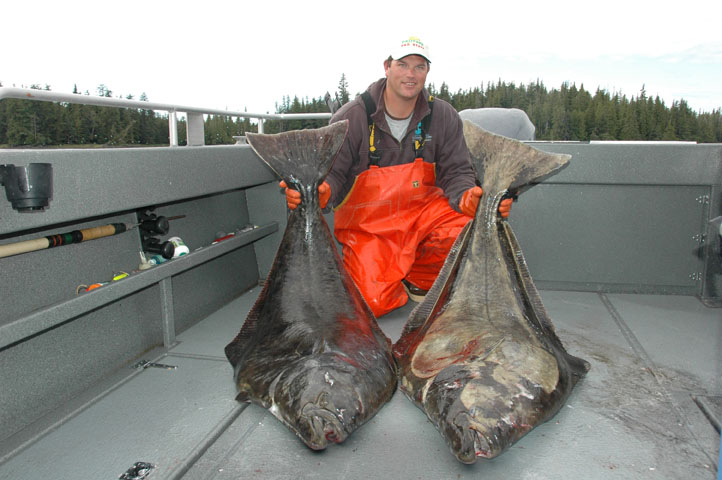
Circle Hooks
Circle hooks work great for halibut because once they’re set in the halibut’s mouth they simply don’t come out. A second advantage is that fish are much easier to release with a circle hook because the hook nearly always ends up in the corner of the halibut’s mouth and not inside the mouth or even worse, down the halibuts throat.
Getting a solid hook set with a circle hook is easy, don’t set the hook. That’s right…DO NOT SET THE HOOK! Let a halibut munch on the bait until the rod is pulling down steadily and then start reeling slowly. The majority of the time the hook will embed in the corner of the halibut’s mouth as it swims away against the pressure.
If for some reason the fish drops the bait after you’ve reeled up slightly, open up the bail on the reel and drop the bait back to the bottom again immediately. I can’t tell you how many times I’ve had the same fish pounce on the bait the second it was dropped back to the bottom.
Keep these hooks as sharp as possible! It surprises me how many people will drop last year’s rusty circle hook overboard expecting to catch fish. Old hooks will still work as long as a hook file is taken to them to hone the point and remove the rust from the hook, but without a touch up they are nearly worthless. It’s no surprise that a sharp, smooth hook will penetrate and slide into a halibut’s jaw more easily than a rusty, dull hook.
A 16/0 Mustad circle hook gets the most use on my boat when we’re targeting chicken halibut. On the rare occasion that one of our customers wants to target Barnie barndoor halibut I’ll run 22/0 circle hooks and use salmon heads for bait, using as much of the salmon guts as possible to lay down a scent trail.
I like to offset my circle hooks about an 1/8th of an inch, or so. Adding an offset improves the hook-up ratio quite a bit. There’s a reason why many offshore billfish tournaments don’t allow offset circle hooks…because they work.
Here's a circle hook rigged with a giant hoochie skirt and a Mustad Sure Strike Capsule that's worked great for me the last couple of years!
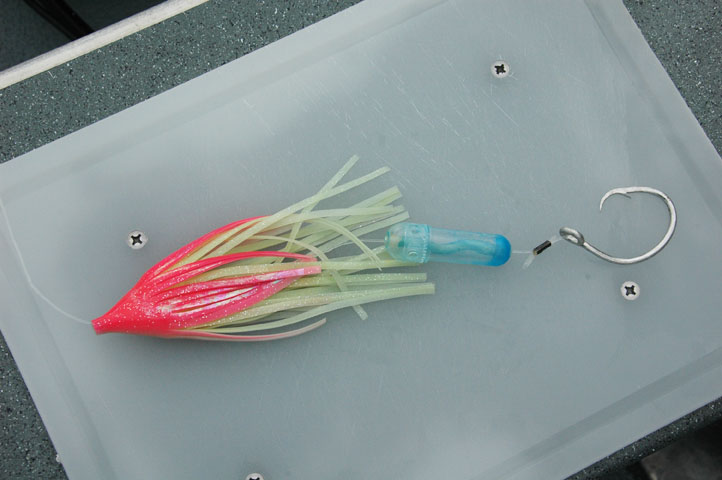
J-Hooks
When I have to rig up a J-Hook rig I go with 8/0 to 10/0 Mustad hooks and as you can tell I'm a fan of plastics, so it usually has some sort of hoochie rigged up in front of the hooks. For fishing halibut in Puget Sound and the Strait of Juan de Fuca I highly recommend a rig like this because you might be fishing for one to several bites a day. There's no sense in using a circle hook only to have a halibut pick up your bait, miss the hook, and never bite again. If you're in areas with a lot of halibut, however, and you need to release quite a few halibut in a days fishing do not use J-hooks. Reserve J-hooks for times when every bite counts!
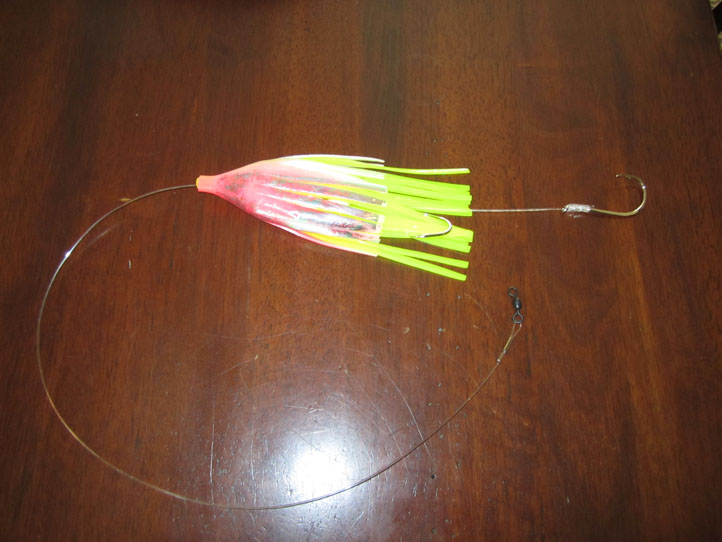
Scents for Halibut
Halibut live on the deep, dark ocean floor and rely heavily upon their sniffers to lead them to a meal and providing a scent trail can draw fish in from a long ways away. Jigs and bait rigs should all be packed with scent for this very reason. Tipping jigs with bait strips, Berkley Gulp, and adding scent gel all works great to lay down a scent trail.
Bait rigs add plenty of scent on their own, but soaking baits in additional scent creates a high-octane scent bomb. A scent that been a winner for me for me in Southeast Alaska is Pautzke’s Nectar. Nectar is the runoff from the egg curing process at the Pautzke factory and is loaded with fish attracting scent. I will soak our salmon belly strips or bottomfish belly strips in this scent overnight in a Zip Loc bag. These baits lay a plume of scent on the bottom that draws both halibut and lingcod in quickly.
Other great scents to use are herring gel, krill, sturgeon feast, anise, and shrimp/anise. If I see a lot of bait near the bottom I’ll generally go with herring gel and if I’m fishing in and around rocky pinnacles I’ll add some shrimp scent.
When we're fishing with jigs in Alaska I will always, always tip them with some sort of bait. Salmon belly strips work the best, but herring fillets and fish skin soaked in Pautzke's Nectar are also proven fish catching baits. The scent from bait greatly improves the amount of hookups you'll get jigging!
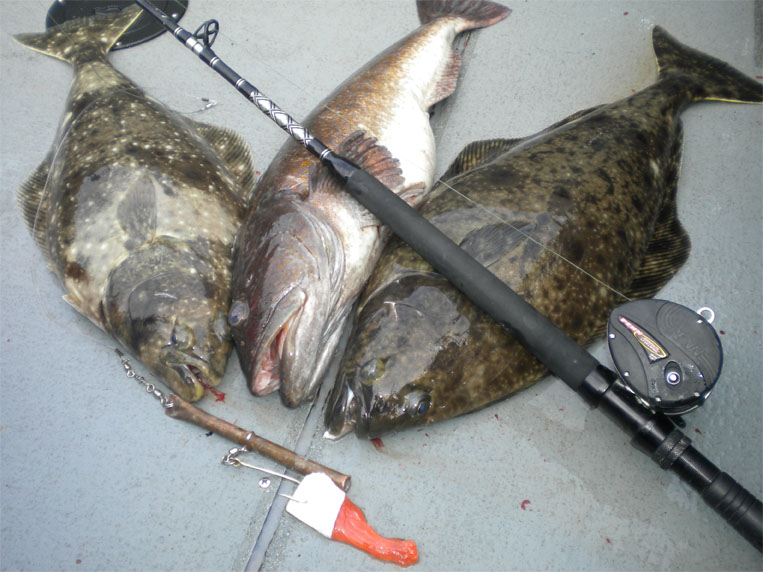
Colors
Glow-in-the-dark white grubs and giant glow-in-the-dark hoochie’s have been my go-to plastics for years. These plastics aren’t just for jigging either. They also work great on a bait rig.
Delta Tackle, Berkley, and Zak's Tackle all make excellent plastics for bottomfishing. The 8” Berkley Gulp grub is standard on most charter boats in Alaska and the Canadians catch a ton of halibut trolling them off downriggers on the offshore banks. Apparently halibut like stale gym socks because that’s exactly what one of these grubs smells like. Whatever the case…they really work!
The benefit to adding a hoochie to a bait rig is that the rig will still attract fish when the bait is partially pulled off the hook. When you’re fishing a quarter mile below the ocean’s surface the last thing you want to do is reel up every time a fish takes a swipe at your bait. That giant hoochie skirt might just give you a few more minutes of bottom time.
The hoochie rig works in just about any color, but I’ve seen the best results from pink/white, green/white, and plain white hoochies in glow in the dark. Rig these hoochies with a handful of Corkies, large beads, or a Mustad Sure Strike capsule above the hook as a spacer and you’ve got a halibut rig that will be lethal on the ocean floor.
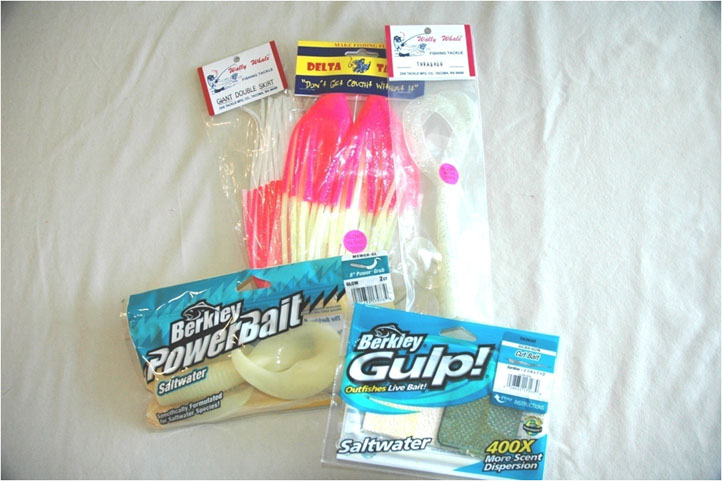
Line
Today’s braided lines are so advanced it doesn’t make any sense to not have them on your halibut reels. The advantage that these lines offer is greatly reduced diameter and added sensitivity, which allows an angler to drop halibut gear straight to the bottom with less drag, and to actually feel the bottom when the weight or jig hits it. Feeling the bottom is especially advantageous when fishing rocky, jig-grabbing structure.
All of my reels have 100 pound Dacron backing on them and they are topped off with 250 to 300 yards of 100 pound Trilene Big Game super braid. The heavy backing provides enough bulk on the spool to fill part of the spool before the super braid is added. Use a uni-knot to connect the two lines together while you’re spooling your reel.
I typically fish water that’s between 150 and 400 feet deep in Alaska, but colleagues that fish the Washington coast will often pound water that is 500 to as deep as 800 feet deep. Yikes! For those conditions I recommend dropping down to 50 or 60 pound braid for reduced line drag.
Halibut simply aren’t leader shy! I know halibut fisherman that use weed-eater twine for leader and believe me, they catch plenty of halibut. I typically use 150 to 200 pound test for my halibut leaders. I can grab the line when halibut hit the surface without worrying about snapping the fish off and my customers can man-handle them as much as possible without a break-off.
Reels
A good reel will be your best friend on the halibut grounds. You’ll want to choose a reel with a large handle and the highest gear ratio possible. The fewer revolutions you have to turn the reel to get the fish up from the bottom the better. Halibut fishing is a marathon and can be downright brutal work, so do everything in your power to make it as easy as possible.
My reel of choice in Southeast Alaska is a Penn 340 GT level wind. They fit nicely on my Lamiglas 6080 halibut rods and are tough, usually lasting all summer without failure.
Halibut Rods
I use the Lamiglas 6080 stand up rods that are rated at 30 to 80 pound for the bulk of our bottomfishing in Southeast Alaska because they have enough horsepower to haul up a big halibut and they are just sensitive enough to feel a jig hitting the bottom. They are fairly heavy rods that are excellent for pounding heaving gear on the bottom and cranking up countless halibut.
When shopping for a rod be sure to buy one with a base that’s fitted for a fighting belt. Most halibut rods will usually have a cap on the butt of the rod that can be pulled off, exposing a seat that fits into a belt. A belt makes it much easier to lift a heavy halibut from the deeps. Consider this when shopping for rods. Fighting caps can also be fitted over the end of these rods.
Swivels
I use stainless three-way corkscrew swivels for all of my bait fishing and a single corkscrew swivel when we’re fishing jigs in Alaska. Before the season begins I’ll make up as many as fifty to a hundred 3 foot shock leaders with 200 pound test by crimping a swivel on one end and a corkscrew swivel on the other. I use these shock leaders whenver we are using jigs. When there’s a break-off jigging I can quickly tie on a shock leader, spin on a new jig, and we’re back in business quickly.
Since I run such heavy leaders with my circle hook/bait rigs I don’t have many problems with line twist or tangles on the bottom and don’t need to run spreader bars. Many of my co-horts will run an additional three foot section of tuna cord with their bait rigs, but I choose to run my braid straight to the three-way corkscrew. I spin the lead onto one leg of the three-way and my bait rig to the other one and down she goes. I can quickly swap out leaders with this setup and when my guests hang up the gear in the rocks I’m not losing a spreader bar "and" a bunch of gear with it..
Harpooning Halibut
My harpoon is about 6 feet long with a smooth flying tip on the end that punctures halibut easily. Most tips will come with a short piece of cable that you connect your bouy line to. Inspect this cable often for wear around the crimps.
I like to use a 10 to 12 foot long bouy line made of either lead line or a nylon line that coils easily. Throwing a mess of yellow poly floating crab line over board with a pissed off halibut on the other end can be just that…a mess.
When I know we have a halibut on the hook that needs harpooning I’ll place the bouy in my deck bucket and coil the line up on top of it. This keeps the line from getting around peoples feet, or even worse, my own feet. A Scottsman’s style bouy that’s about the size of a basketball works fine for this.
The moment of truth! I like to stick halibut thru the gill plates. With a little force it’s fairly easy to push the harpoon tip all the way thru both plates and more often than not I’ll hit a couple of gills on the way thru, which starts the bleeding process.
Sticking them just behind the gill plates is also a good bet. The nice thing about harpooning them in this location is that if you hit the spine it’s Good Night Irene! You’ll want to avoid the belly cavity, as this is the softest tissue in the entire fish and I’ve seen tips pull out of this area. No beuno!
Just remember to hold onto the stick after you push the tip thru the halibut. Many a harpoon stick has been lost overboard by letting go of the stick after a halibut is harpooned. Also, don’t forget to wear gloves to handle the line. I like to wear the long heavy-duty rubber work gloves when I’m handling halibut and bottomfish.
Here's a video one of my customers shot harpooning and shooting a 125 pound halibut off the west side of Prince of Wales Island about five years ago:
There you have it…a few tips for rigging up for the upcoming halibut season. Hopefully some of this advice will come in handy if you're lucky enough to tie into one of these fine-eating creatures.
If you have any questions about any of this feel free to post them in the Outdoor Line Fishing Forums and either myself or one of the other saltwater anglers on the board will be happy to answer them. Good luck halibut fishing this spring everyone!
Rob Endsley
The Outdoor Line
710 ESPN Seattle
www.theoutdoorline.com


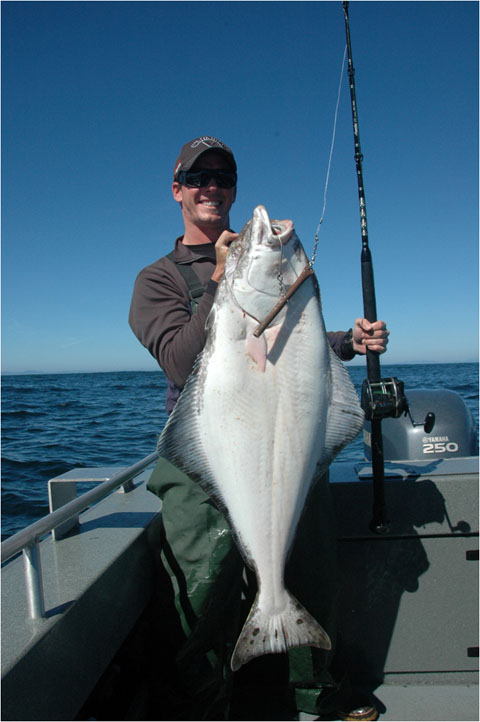
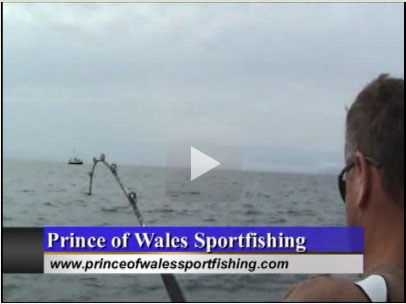
Awesome article! Very useful!
If you're drifting you can harpoon them, toss the bouy over and then pick them up. If you've harpooned them correctly they won't come off. If you're on anchor use a fairly long buoy line and place the bouy about in the middle, then tie off the end of the line to a cleat. Once they are done thrashing against the bouy you can haul them up the boat and it's game over. Hope that helps Ian!
Fantastic write up thankyou very much. I live just south of you in Canada, on Vancouver Island. Victoria, BC. I have just started Halibut fishing tis year, and enjoyed your arcticle very much. Do you have another line attached to the buoy once it is thrown over, or do you rely on the Halibut staying on the hook. What happens if the hook releases and you are at anchor. How do you retreive the fish and buoy. Thanks in adavance.
Thanks Chris! Well worth the long drive up there to see everybody again. Some great folks in that Anacortes PSA club. Good luck fishing man!
Thanks for making the trip up to Anacortes, Robbo. Good to see you and great seminar!